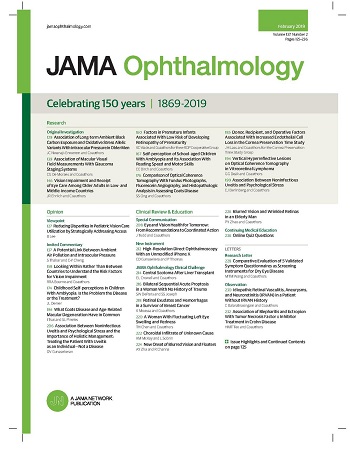Two-Year Outcomes of Phacogoniotomy vs Phacotrabeculectomy for Advanced Primary Angle-Closure Glaucoma With Cataract: A Noninferiority Randomized Clinical Trial.
IF 7.8
1区 医学
Q1 OPHTHALMOLOGY
引用次数: 0
Abstract
Importance Intraocular pressure (IOP) reduction with phacogoniotomy (phacoemulsification plus goniosynechialysis plus goniotomy) was not less than that of phacotrabeculectomy for advanced primary angle-closure glaucoma (PACG) with cataract at 1-year follow-up, but longer-term outcomes are needed. Objective To investigate if phacogoniotomy is noninferior to phacotrabeculectomy for advanced PACG with cataract at 2 years. Design, Setting, and Participants This multicenter, noninferiority, randomized clinical trial took place in 7 ophthalmology centers in China. The trial started May 31, 2021, and 2-year follow-up ended May 31, 2024. Included in this analysis were patients with advanced PACG and cataract. Study data were analyzed from September 2024 to January 2025. Interventions Random assignment (1:1) to phacogoniotomy or phacotrabeculectomy. Main Outcomes and Measures The primary outcome measure was reduction in IOP from baseline to the 2-year visit with a noninferiority margin of 4 mm Hg. Results A total of 124 participants (124 eyes) were randomized (mean [SD] age, 66.4 [8.6] years; 67 female [54.0%]), 65 (52.4%) to the phacogoniotomy group and 59 (47.6%) to the phacotrabeculectomy group. A total of 59 patients (90.7%) in the phacogoniotomy group and 52 patients (88.1%) in the phacotrabeculectomy group completed 2-year visits. All participants were Chinese. Mean (SD) IOP reduction was -25.6 (10.2) mm Hg and -24.7 (9.4) mm Hg in the phacogoniotomy and phacotrabeculectomy groups, respectively, and the upper boundary of the CI for difference in change between groups was lower than the 4-mm Hg noninferiority margin (mean difference, -0.5 mm Hg; 97.5% CI, -1.7 mm Hg to 0.8 mm Hg; P = .42). The mean difference for complete success for phacogoniotomy vs phacotrabeculectomy was -6.7% (95% CI, -21.4% to 8.8%; P = .47) and for qualified success was 1.4% (95% CI, -11.0% to 14.3%, P = .30). Median (IQR) number of antiglaucomatous medication was 0 (0) vs 0 (0; Hodges-Lehmann estimate of location shift, 0; 95% CI, 0; P =.12) with phacogoniotomy vs phacotrabeculectomy, respectively (mean difference, 0.13; 95% CI, -0.36 to 0.63; P = .60). Conclusions and Relevance Mean IOP reduction with phacogoniotomy was noninferior to phacotrabeculectomy for advanced PACG and cataract at 2-year follow-up with no differences detected in complete or qualified success or mean number of antiglaucomatous medications. These findings support phacogoniotomy as an alternative to phacotrabeculectomy for patients with advanced PACG and cataract. Trial registration ClinicalTrials.gov Identifier: NCT04878458.眼小梁切除术与眼小梁切除术治疗晚期原发性闭角型青光眼合并白内障的两年疗效:一项非效性随机临床试验。
重要性:对晚期原发性闭角型青光眼(PACG)合并白内障患者进行1年随访时,超声乳化术(超声乳化术+巩膜协同术+巩膜切开术)降低眼压(IOP)的效果不低于超声小骨切除术,但需要更长期的观察结果。目的探讨超声小梁切除术治疗晚期PACG伴白内障2年的疗效是否优于超声小梁切除术。设计、环境和参与者这项多中心、非劣效性、随机临床试验在中国的7个眼科中心进行。试验于2021年5月31日开始,为期2年的随访于2024年5月31日结束。本分析包括晚期PACG和白内障患者。研究数据分析时间为2024年9月至2025年1月。干预措施:随机分配(1:1)至虹膜切除术或虹膜小梁切除术。主要结果和测量主要结果测量是IOP从基线到2年随访期间的降低,非劣效性差为4 mm hg。结果共124名参与者(124只眼睛)被随机化(平均[SD]年龄66.4[8.6]岁;女性67例(54.0%),超声小梁切除术组65例(52.4%),超声小梁切除术组59例(47.6%)。超声小梁切除术组59例(90.7%)和超声小梁切除术组52例(88.1%)完成2年访视。所有参与者都是中国人。平均(SD)眼压降低值分别为-25.6 (10.2)mm Hg和-24.7 (9.4)mm Hg,两组间变化差异的CI上边界低于4 mm Hg的非效性边界(平均差异为-0.5 mm Hg;97.5% CI, -1.7 mm Hg ~ 0.8 mm Hg;p = .42)。超声小梁切除术与超声小梁切除术完全成功的平均差异为-6.7% (95% CI, -21.4%至8.8%;P = 0.47),合格成功率为1.4% (95% CI, -11.0%至14.3%,P = 0.30)。抗青光眼药物的中位数(IQR)为0 (0)vs 0 (0);Hodges-Lehmann位置位移估计,0;95% ci, 0;P = 0.12),平均差值为0.13;95% CI, -0.36 ~ 0.63;p = .60)。结论和相关性:随访2年,对于晚期PACG和白内障患者,采用晶状体小梁切开术降低眼压的效果不低于采用晶状体小梁切开术,在完全或合格的成功或抗青光眼药物的平均数量方面没有发现差异。这些发现支持对晚期PACG和白内障患者行超声小梁切除术而非超声小梁切除术。临床试验注册:clinicaltrials .gov标识符:NCT04878458。
本文章由计算机程序翻译,如有差异,请以英文原文为准。
求助全文
约1分钟内获得全文
求助全文
来源期刊

JAMA ophthalmology
OPHTHALMOLOGY-
CiteScore
13.20
自引率
3.70%
发文量
340
期刊介绍:
JAMA Ophthalmology, with a rich history of continuous publication since 1869, stands as a distinguished international, peer-reviewed journal dedicated to ophthalmology and visual science. In 2019, the journal proudly commemorated 150 years of uninterrupted service to the field. As a member of the esteemed JAMA Network, a consortium renowned for its peer-reviewed general medical and specialty publications, JAMA Ophthalmology upholds the highest standards of excellence in disseminating cutting-edge research and insights. Join us in celebrating our legacy and advancing the frontiers of ophthalmology and visual science.
 求助内容:
求助内容: 应助结果提醒方式:
应助结果提醒方式:


